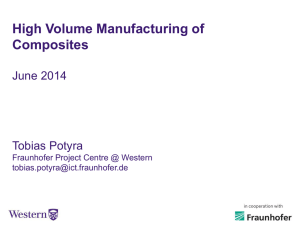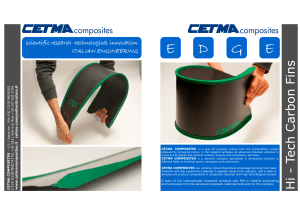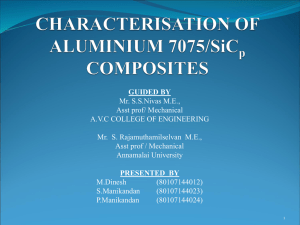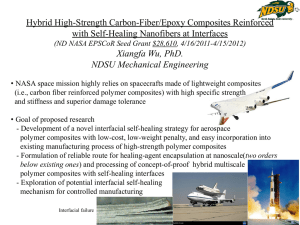Chapter 7 - Loy Research Group
advertisement
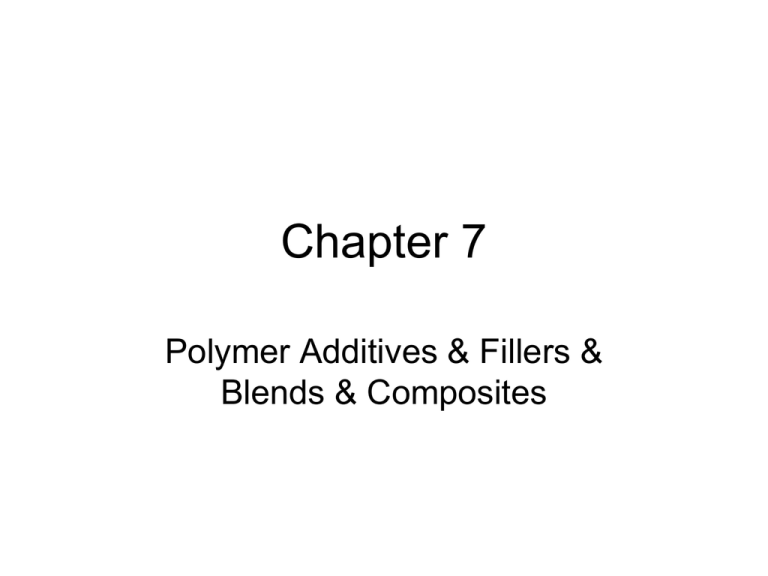
Chapter 7 Polymer Additives & Fillers & Blends & Composites Polymer-Polymer Solutions: Polymer Blends • Miscible blends-averaging of properties of two different materials. Raising the Tg or strength or toughness of a cheap polymer. • Immiscible Blends: Composite structures-properties may be synergistically greater than those of constituent materials Blends: Thermodynamics Combinatorial entropic contribution (usually can be ignored) Enthalpic difference in solubility: ≥ 0 Minimize difference in solubility parameters () But even small positive will cause G > 0 Polymer Solubility • When two hydrocarbons such as dodecane and 2,4,6,8,10pentamethyldodecane are combined, we (not surprisingly) generate a homogeneous solution: • It is therefore interesting that polymeric analogues of these compounds, poly(ethylene) and poly(propylene) do not mix, but when combined produce a dispersion of one material in the other. n n Extremely low probability of matching solubilities Polymer Miscibility (Temp-Composition) Phase Diagrams Upper critical solution temperature Heat up mixture & entropy rules This is for Hildebrant interactions only: No strong non-bonding interactions & theta solvent Polymer Miscibility (Temp-Composition) Phase Diagrams: Free Energy Single Phase Region Free Energy Phase separation would result in a net increase in energy Polymer Miscibility (Temp-Composition) Phase Diagrams: Free Energy Two Phase Region Free Energy Anywhere between 30 & 70% leads to decomposition to two phases with 30 & 70% comps. More phase diagrams: Between spinoidal limits: spontaneous phases sep. Between ' and spinoidal limit: kinetics (nucleation) rules Result of thermodynamics vs kinetic control UCST Plot with spinoidal lines Effects of Mw (# monomer repeat units) On Phase Separation Polymer Miscibility (Temp-Composition) Phase Diagrams: Strong Non-bonding Interactions A new term needs to be added to free energy equation to account for non-bonding interactions Lower critical solution temperature (LCST) More Thermodynamics If we ignore the combinatorial entropic contributions (ok) then the equation simplifies to: For solubility GH ≤ 0 or ≥0 Repulsive Attractive Lower critical solution temperature (LCST) Plot for Polystyrene with Polyvinyl-methyl ether Miscible Blend based on weak interactions Noryl Some others: PMMA-PEO; PVAPEO, PS-PVME Some miscible blends Mini Cooper / Cooper S, radiator grille & PETE Miscible Blend PMMA PVF PVF is blended into PMMA to make the latter more resistant to UV Blends with: PVA PMMA PC Effects of Blends on Tg Blends Immiscible Blends Controlling Phase segregation Compositional quenching Surfactants block polymers Compatibilizers (usually a smalll amt of block copolymer) Nature Materials, 2002, 1, 8 - 10 LCST SAN-PMMA Blends composed of separate polymers: Compositional Quenching Optical Phase Contrast Microscope The dark, continuous phase is polymethyl methacrylate (PMMA). The lighter, irregular regions are PS. The dark particles inside the PS are PB PP-NBR Blend Immiscible Blends Using Immiscibility to an Advantage Completely immiscible High Impact Polystyrene Best if the polymers are connected into a block-copolymer Using Immiscibility to an Advantage Lining of PET soda bottles lamellar morphology 1:2 (PTV:PCBM) 1:3 (PTV:PCBM) 1:4 (PTV:PCBM) 1:6 (PTV:PCBM) 1:10 (PTV:PCBM) C12H25 S n Blends are not easy to make: • Blends are not easy to discover-often copolymers are needed to make blend with another homopolymer • Phase separation gets out of hand in immiscible systems without compatibilizers. • Some blends must be made with solvent. Immiscible Blends with 2 homopolymers HDPE + 30 wt% Nylon 6 EPR + 30 wt% PP Immiscible Blends with 2 homopolymers can be mixed But with time coalescence coarsens featues Immiscible Blends with 2 homopolymers & compatiblizer LDPE/PS blend without a compatibilizer LDPE/PS blend with a compatibilizer Block Copolymers Block Copolymers Making Hybrid Materials: Class 1E (Interpenetrating network or IPN) •Two lightly crosslinked • Together they are networks stronger, tougher than •Cannot be untangled. sum of the individual •Each network has different polymers = synergistic mechanical Properties. All organic IPN adhesives & coatings POLYMERICS IPNS Conventional epoxy Networks Interpenetrating Networks http://www.polymerics.de/technology/ipn_en.html#vorteile Simultaneous Interpenetrating network polymers •The two networks assembled at the same time •Phase separation of hard colloidal particles would ruin IPN Sequential Interpenetrating networks •The two networks are not assembled at the same time •In this case the inorganic network is assembled before the organic Synthesis of poly(methylphenylsiloxane)/phenylenesilica hybrid material with interpenetrating networks and its performance as thermal resistant coating Gao, D. and Jia, M. J. Appl. Polym. Sci. 2012. Synthesis of poly(methylphenylsiloxane)/phenylenesilica hybrid material with interpenetrating networks and its performance as thermal resistant coating Stable > 300 °C Gao, D. and Jia, M. J. Appl. Polym. Sci. 2012. doi: 10.1002/app.38372 Tensile 10-20 MPa Organic–inorganic polymer hybrids based on unsaturated polyester •Sol-gel polymerization of phenyltriethoxysilane in presence of Linear organic polymer •Photochemical cure of organic network Journal of Non-Crystalline Solids, 2002, 311, 195–198 Simultaneous Interpenetrating networks: "Inverse" organic-inorganic composite materials. Monomer containing both silica and organic components splits apart Macromolecules, 1991, 24 (19), pp 5481–5483 Simultaneous Interpenetrating networks: "Inverse" organic-inorganic composite materials. For a hybrid to be an IPN, there must be a nonlinear, synergistic effect on the mechanical properties Macromolecules, 1991, 24 (19), pp 5481–5483 Composites The essence of the concept of composites is that the load is applied over a large surface area of the matrix. Matrix then transfers the load to the reinforcement, which being stiffer, increases the strength of the composite. It is important to note that there are many matrix materials and even more fiber types, which can be combined in countless ways to produce just the desired properties. In the United States, composites manufacturing is a 25 billion dollar a year industry. There are about 6000 composites related manufacturing plants and materials distributors across the U.S. The industry employs more than 235,000 people. An additional 250,000 people are employed in businesses that support the composites industry, including materials suppliers, equipment vendors, and other support personnel. About 90% of all composites produced are comprised of glass fiber and either polyester or vinylester resin. Composites are broadly known as reinforced plastics. Composites A composite is: Two or more distinct materials that interface on a macroscopic scale To achieve best properties not possessed by any one acting alone. 56 Composites – Polymer Matrix Polymer matrix composites (PMC) and fiber reinforced plastics (FRP) are referred to as Reinforced Plastics. Common fibers used are glass (GFRP), graphite (CFRP), boron, and aramids (Kevlar). These fibers have high specific strength (strength-to-weight ratio) and specific stiffness (stiffness-to-weight ratio) Matrix materials are usually thermoplastics or thermosets; polyester, epoxy (80% of reinforced plastics), fluorocarbon, silicon, phenolic. Composites are all around us 58 Composites have a long use in military 59 A composite has three elements Reinforcement: Makes up the ‘skeleton’ which provides mechanical strength Matrix: Binds the reinforcing fibers and distributes the load Additives / Fillers: Provide special attributes not in the base materials PETE HDPE PP PS PVC PEEK Wet Out Sizing Talc Chalk Flowablility Fire Retardant 60 What makes composites attractive Reduced weight Corrosion resistance High specific strength and stiffness High resistance to chemicals and weathering (UV) Good fatigue strength Functional integration Energy absorbing Design flexibility Durability: 61 Main limitations of composites Initial expense Impact strength High temperature 62 Reinforcement Forms Woven perpendicular warp and weft yarns Glass fiber E-glass C-glass S-glass Polymer: Kevlar Nomex Carbon (PAN or Pitch) Ceramic: Si-C, Si3N4, or BN 63 Typical properties of fibers 64 Wood-Polymer Composites Oriented strand board Particle Board Masonite Pegboard Composites are used in Commercial Aircraft 66 Application of Composites in Aircraft Industry 20% more fuel efficiency and 35,000 lbs. lighter Properties of Reinforced Plastics The mechanical properties of reinforced plastics vary with the kind, shape, relative volume, and orientation of the reinforcing material, and the length of the fibers. Effect of type, length, % volume, and orientation of fibers in a fiber reinforced plastic (nylon) Advantages of Composites Higher Specific Strength (strength-to-weight ratio) Composites have a higher specific strength than many other materials. A distinct advantage of composites over other materials is the ability to use many combinations of resins and reinforcements, and therefore custom tailor the mechanical and physical properties of a structure. The lowest properties for each material are associated with simple manufacturing processes and material forms (e.g. spray lay-up glass fibre), and the higher properties are associated with higher technology manufacture (e.g. autoclave moulding of unidirectional glass fibre), the aerospace industry. Advantages of Composites Design flexibility Composites have an advantage over other materials because they can be molded into complex shapes at relatively low cost. This gives designers the freedom to create any shape or configuration. Boats are a good example of the success of composites. Corrosion Resistance Composites products provide long-term resistance to severe chemical and temperature environments. Composites are the material of choice for outdoor exposure, chemical handling applications, and severe environment service. Advantages of Composites Low Relative Investment One reason the composites industry has been successful is because of the low relative investment in setting-up a composites manufacturing facility. This has resulted in many creative and innovative companies in the field. Durability Composite products and structures have an exceedingly long life span. Coupled with low maintenance requirements, the longevity of composites is a benefit in critical applications. In a half-century of composites development, well-designed composite structures have yet to wear out. In 1947 the U.S. Coast Guard built a series of forty-foot patrol boats, using polyester resin and glass fiber. These boats were used until the early 1970s when they were taken out of service because the design was outdated. Extensive testing was done on the laminates after decommissioning, and it was found that only 2-3% of the original strength was lost after twenty-five years of hard service. Disadvantages of Composites Composites materials are difficult to inspect with conventional ultrasonic, eddy current and visual NDI methods such as radiography. American Airlines Flight 587, broke apart over New York on Nov. 12, 2001 (265 people died). Airbus A300’s 27-foot-high tail fin tore off. Much of the tail fin, including the so-called tongues that fit in grooves on the fuselage and connect the tail to the jet, were made of a graphite composite. The plane crashed because of damage at the base of the tail that had gone undetected despite routine nondestructive testing and visual inspections. Disadvantages of Composites Composites are heterogeneous properties in composites vary from point to point in the material. Most engineering structural materials are homogeneous. Composites are highly anisotropic The strength in composites vary as the direction along which we measure changes (most engineering structural materials are isotropic). As a result, all other properties such as, stiffness, thermal expansion, thermal and electrical conductivity and creep resistance are also anisotropic. The relationship between stress and strain (force and deformation) is much more complicated than in isotropic materials. The experience and intuition gained over the years about the behavior of metallic materials does not apply to composite materials.

